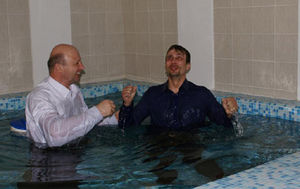History of Baptism: Difference between revisions
No edit summary |
No edit summary |
||
| Line 29: | Line 29: | ||
<div style="border-bottom:1px #B87333 solid; text-align:center; font-size:140%; padding:1px; margin:1px;">Historical evidence of baptism in the Early Christian Churches</div> | <div style="border-bottom:1px #B87333 solid; text-align:center; font-size:140%; padding:1px; margin:1px;">Historical evidence of baptism in the Early Christian Churches</div> | ||
All the histories agree that the Early Church baptised by immersion in the Name of | All the histories agree that the Early Church baptised by immersion in the Name of Jesus Christ. This means that all of Jesus' disciples, the Apostle Paul, and even Mary (Jesus' mother) were baptised in the Name of Jesus Christ after the day of Pentecost. | ||
'''Encyclopedia Britannica''': | '''Encyclopedia Britannica''': | ||
| Line 39: | Line 39: | ||
:''Baptism was always in the name of “Lord Jesus” until Justin Martyr when triune formula was used.'' (Vol. 2 Pg. 389) | :''Baptism was always in the name of “Lord Jesus” until Justin Martyr when triune formula was used.'' (Vol. 2 Pg. 389) | ||
<div style="border-bottom:1px #B87333 solid; text-align:center; font-size:140%; padding:1px; margin:1px;">A short look at Catholic, Orthodox, and Infant Baptism</div> | |||
<div style="border-bottom:1px #B87333 solid; text-align:center; font-size:140%; padding:1px; margin:1px;">A short | |||
'''Catholic Baptism''' | '''Catholic Baptism''' | ||
| Line 58: | Line 56: | ||
'''Infant Baptism''' | '''Infant Baptism''' | ||
The Catholic, Orthodox, and Anglican Churches each baptize infants, while many Protestant churches do not baptize infants. | The Catholic, Orthodox, and Anglican Churches each baptize infants, while many Protestant churches do not baptize infants. | ||
{{Portal Navigation}} | {{Portal Navigation}} | ||
Revision as of 20:45, 18 July 2014

The Jewish Ritual of Baptism
Immersion in a ritual bath (Mikvah)is required for Ger tzedek (converts to Judaism) as part of their conversion. Other rituals for conversion to Judaism include circumcision and an understanding and observance of all the relevant laws. In the Tanakh, and other Jewish texts, bathing for ritual purification was established for specified circumstances; in order to be restored to a condition of 'ritual purity'. For example, Jews who become ritually 'defiled' by contact with a corpse (according to the Law of Moses), had to use the mikvah before being alowed to participate in the Holy Temple. Through practices such as these, immersion in the mikveh represent purification and restoration, and qualification for full religious participation in the life of the community. (See Book of Numbers Chapter 19) In modern times, the adherence and observance of the laws, rituals, and customs regarding the mikvah differ greatly among the Jewish denominations. The only modern exception is that after menses, women need to immerse in a mikvah in order to be permitted to her husband.
John the Baptist
John the Baptist, a prophet who preached before Jesus started teaching, foretold the soon coming of the Messiah. John was called the Baptist, as he and his disciples would baptise (immerse in water) those who believed his message of repentance for the remission of sins. Jesus himself was baptised by John the Baptist.
Historical evidence of baptism in the Early Christian Churches
All the histories agree that the Early Church baptised by immersion in the Name of Jesus Christ. This means that all of Jesus' disciples, the Apostle Paul, and even Mary (Jesus' mother) were baptised in the Name of Jesus Christ after the day of Pentecost. Encyclopedia Britannica:
Hastings Encyclopedia of Religion
A short look at Catholic, Orthodox, and Infant Baptism
Catholic Baptism The papacy says a sacrament must contain three elements to be valid:
The Catholic Church also says, with regards to baptism, that the correct intention is to do what the Church does as a matter of tradition. The tradition of the Catholic church is to baptise by aspersion (sprinkling water over the head) or affusion (pouring water over the head) in the name of the Father and of the Son and of the Holy Spirit. Orthodox Baptism The Orthodox Church teaches sprinkling or pouring in the name of the Father and of the Son and of the Holy Spirit. The Orthodox church also teaches that baptism should be preceded by fasting, and that, if cool running water is not available, the baptism should be done three times rather than once. (Didache, Chaper 7). Infant Baptism The Catholic, Orthodox, and Anglican Churches each baptize infants, while many Protestant churches do not baptize infants.
|